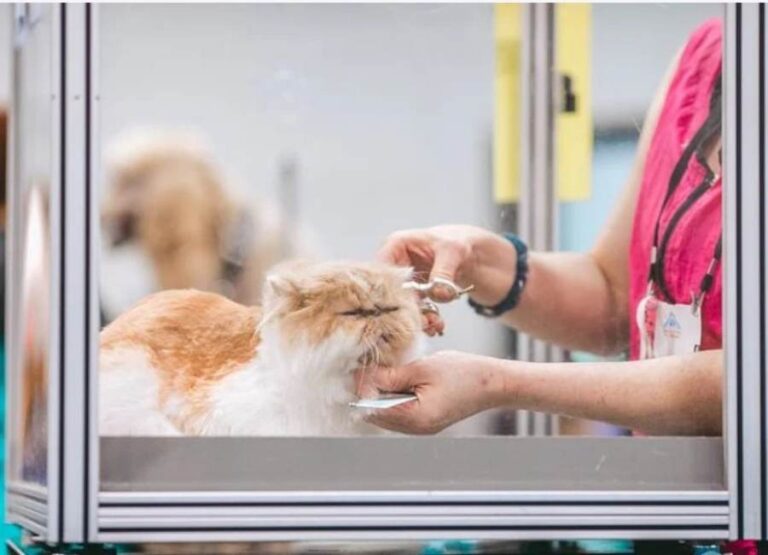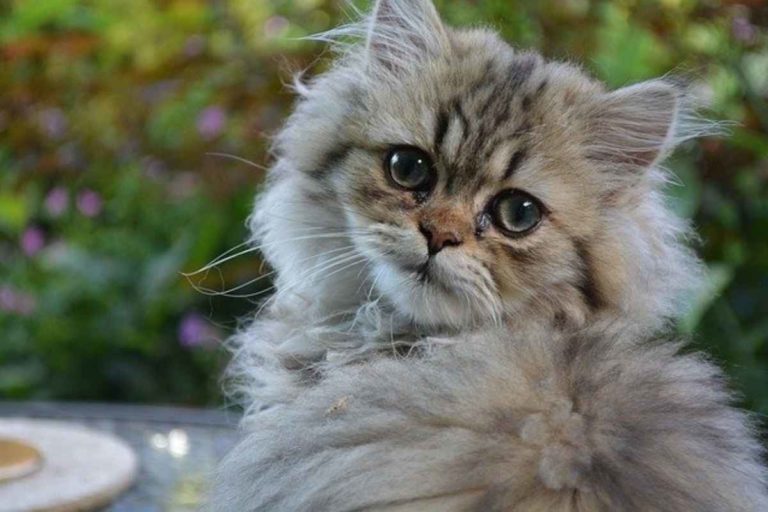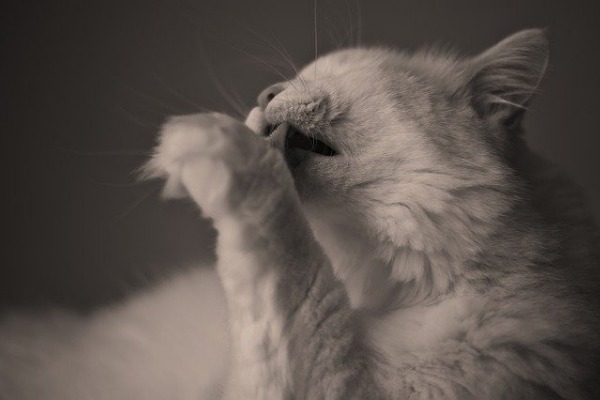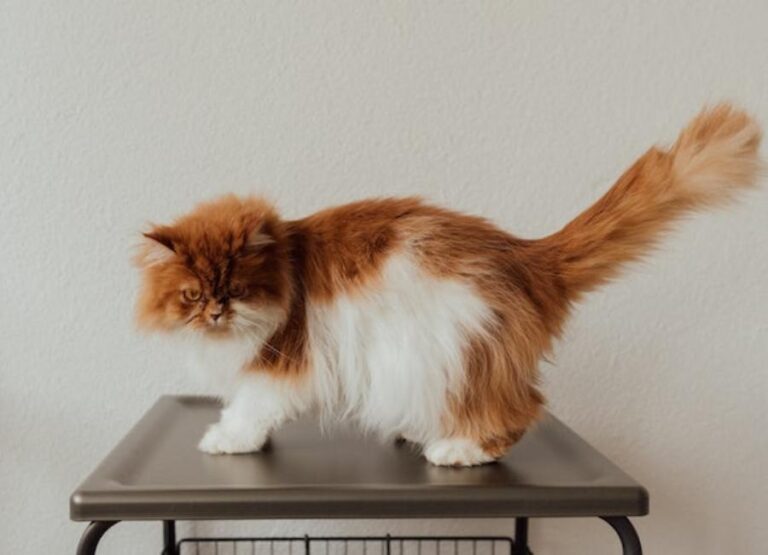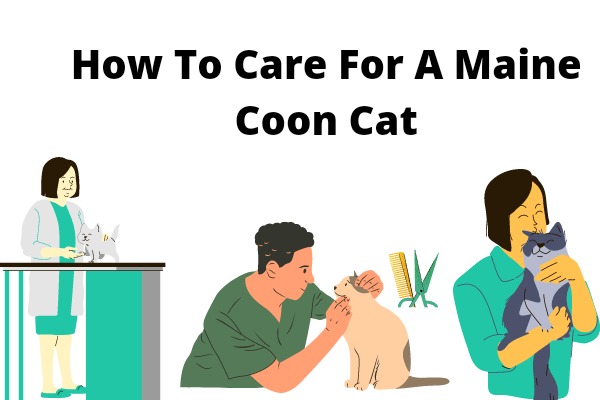Mainecoon Grooming: 6 Grooming Tips & Benefits
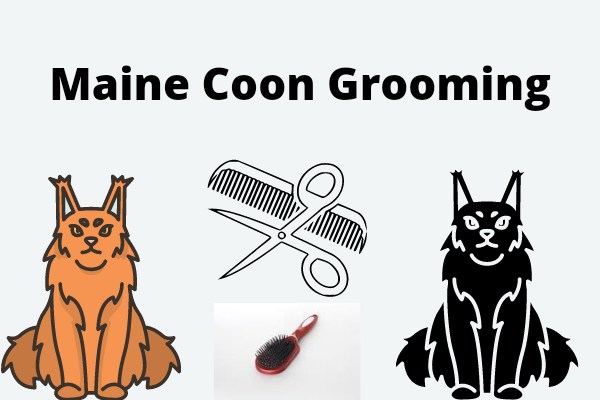
There have been many questions about Mainecoon grooming, which should be a simple process.
In this post, you will learn how to groom your Mainecoon cat and much more about Mainecoon grooming!!!
Long-haired cats like Mainecoons need the use of specialized grooming equipment.
Most groomers advocate using a wire slicker brush, an undercoat brush with broad and narrow teeth, a finer-toothed comb to comb through the undercoat after using the narrower brush, a flea comb for short-furred areas like the head, and a mat splitter.
Grooming is important if you do take your Mainecoon cat outside on a walk.
Mainecoon Grooming
Brushing the thick, dense fur of a Mainecoon 2-3 times a week to avoid tangles and matting isn’t the only way to groom them.
Brushing their cats’ teeth on a regular basis is also necessary for maintaining dental hygiene in Mainecoons.
Claws, especially on indoor Mainecoon cats, should be clipped.
Bathing aids in the removal of dirt and loosening of dead fur.
Grooming requirements vary depending on the cat’s hair type, age, lifestyle, and overall health.
Some long coats tangle almost never, while others might get matted in minutes.
If your cat’s coat is prone to matting, you may need to brush/comb it on a regular basis. If not, once every three weeks should be enough.
Mainecoon grooming involves the following activities:
- Brushing of fur
- Bathing
- Nail or claw clipping
- Ear cleaning
- Brushing of teeth
Lack of proper grooming is one of the causes of shedding in Mainecoon cats.
Mainecoon Grooming Steps
Here are the steps involved in Mainecoon grooming which are as follows:
Step 1: Assemble the basic Mainecoon grooming tools
When it comes to grooming your Mainecoon cat, the first step is to get all of the necessary grooming tools.
Let’s assume you’re on a tight budget and just have a few dollars to spend on a grooming kit.
The following are some basic grooming items for your Mainecoon cat:
- Cat shampoo (recommended by your vet)
- Vacuum cleaner
- Safari Shedding Comb for Long-haired
- Cat Brush
- Jug for rinsing during and after bathe
- Dryer
- Scissors
- Towels
- Treats
Because some Mainecoon cats become too enthusiastic and active when being brushed, we recommend playing the fetch game before brushing your cat.
Playing the fetch game with your cat helps to deplete the cat’s energy, making him quiet and comfortable, allowing you to brush with ease.
Again, the most important thing is to make sure you start grooming your Mainecoon cat from the kitten stages so that they get used to grooming.
Step 2: Weekly brushing of your Mainecoon cat
Long-haired cats need the use of specialized grooming equipment.
Most groomers advocate using a wire slicker brush, an undercoat brush with broad and narrow teeth, a finer-toothed comb to comb through the undercoat after using the narrower brush, a flea comb for short-furred areas like the head, and a mat splitter.
Types of brushes and tools for brushing Mainecoons
Wire slicker brush: Small, fine wire bristles are curved at an angle on this flat, metal brush. Any loose top fur will be removed using wire slickers.
The Furminator, for example, is a deshedding appliance that substantially reduces stray fur.
I use this tool frequently, and even with regular usage, I am removing enough fur from my long-haired cat to produce a tiny cat!
Dirt, debris, dead skin cells, and loose hair may all be removed from your cat’s coat using a soft-bristled brush.
It’s also useful at the conclusion of a grooming session to disperse oils throughout the coat, making it glossy and smooth.
Metal combs: Metal combs with widely spaced teeth are useful for preventing matting in dense undercoats. Combs get rid of the tougher-to-reach underfur.
Mat splitter: does exactly what it says on the tin. Mats are sometimes unavoidable no matter how well you groom your long-haired cat, and they must be removed for the health of the coat. A seam ripper may be used to break apart matting in a pinch.
Steps for brushing a Mainecoon cat
Here are the simple steps to brush a Mainecoon cat:
Step 1: Start brushing from the cat belly
Start brushing from your cat’s tummy and try to hug your Mainecoon while doing so. Rub your thumb down the chin of your cat.
Brush backward in the same direction as the fur, not against the direction of hair development, and eliminate mats as you brush.
At this point, you should use the Safari Shedding Comb to remove the mat and long hair, then follow up with the cat brush.
To avoid being rough on the Mainecoon’s skin, brush only once or twice with the cat brush, then use the Safari Shedding Comb to remove any remaining hairs.
After the underbelly region, gently turn or switch to the cat’s side and remove any mats using the Safari Shedding Comb.
Use the Safari Shedding Comb on both sides of the cat, then go over the cat side with the cat brush, then use the Safari Shedding Comb to remove any remaining fur.
Always be cautious in the armpit area, as all cats have lighter skin there.
Step 2: Continue brushing up to the back of the cat
After combing the Mainecoon’s tummy, carefully flip the cat over and begin brushing the rear of the cat.
Comb the cat’s fur from the neck to the tail end using the Safari Shedding Comb.
Remember to brush from the neck to the tail end twice with the cat brush, then use the Safari Shedding Comb to remove any hanging fur.
Step 3: Continue brushing down to the hind legs of the cat
Brush the cat’s hind legs with the cat brush after brushing the back. Brush down from the cat tail end to the foot area.
Brush in the direction of the fur, not the reverse, then use the Safari Shedding Comb to remove any hanging fur after brushing.
Step 4: Next is to move to the front legs of the cat
Brush the cat’s front legs after brushing the cat’s back legs. To the front legs, do the same procedure you did with the back legs.
Step 5: Continue to brush down to the cat tail
The tail of a Mainecoon cat is one of the easiest body parts to groom, although not all Mainecoons enjoy having their tails rubbed.
Lay the cat down and comb one side in the direction of the fur with the Safari Shedding Comb.
Brush the bottom side of the cat down to the tip of the cat’s tail using the cat brush.
Step 6: Finally move to the cat head
Last but not least, the cat head is a particularly unique spot to groom.
Only comb the cat’s forehead and chin once or twice with the Safari Shedding Comb; don’t waste time combing the head since your cat might not enjoy it.
If you have a vacuum cleaner, you may use it to clean up after your Mainecoon cat and the area where you brushed him. If you don’t, simply sweep the area.
Step 7: Clip out any mats if any
With your fine-toothed comb, create a barrier between the cat’s skin and the mat. Make sure not to pull on the cat’s fur.
As soon as possible, remove the mat. Your cat is likely to hate having a comb stuck in him and may try to run.
As a result, make every effort to cut the mat as soon as possible.
However, proceed slowly enough to maintain control of your scissors.
You don’t want to accidentally cut your cat’s skin.
If your cat begins hissing and growing aggressively, take a break. The remaining matting may then be cut out.
Step 3: Clipping your Mainecoon cat’s nails
Here are the steps involved in clipping your Mainecoons cat nails:
- Purchase a good-quality nail clipper that is the correct size.
- Allow your Mainecoon cat to investigate and grow acquainted with the clippers.
- Approach the paws with care, caressing and manipulating them at first.
- Make sure they’re comfortably seated in your lap and not going to leap.
- If you observe the cat’s ears folding back, a moving tail, or any other signs of tension, stop immediately and wait for it to calm.
- Gently press your cat’s paws together so that the nails are visible while they are quiet.
- They can use the clippers to trim the long claws if they are at ease.
- Rep the procedure for each of your Mainecoon cat’s four paws.
To avoid injuring your Mainecoon cat, don’t cut too deeply, just cut the tip of the cat nails and don’t cut beyond the colored part of the nails.
Step 4: Caring for your Mainecoon cat ears
Inspect your cat’s ears for any bleeding, sores, debris, discomfort, excessive wax accumulation, or discharge.
Another big issue is ear mites, which cause a brownish-reddish discharge that is difficult to notice with the naked eye.
Cats scratch their ears excessively because of ear mites. A small amount of wax is OK, but a strong odor should be avoided.
Look for lumps, bumps, markings, thickening, scaling, sores, redness, or lumps, among other things.
Make an appointment with your local veterinarian right once if you see any of the symptoms.
How to clean a Mainecoon cat ear
Here is the simple step to clean a Mainecoon cat ears:
- In your cat’s ears, look for debris, ear mites (which appear as little brown or red spots), pain, discharge, or wax accumulation.
- Wrap the cat in a towel before starting the cleaning procedure to keep them from moving.
- Begin by carefully removing the earflap and filling one ear canal with a cleaning solution prescribed by your veterinarian.
- Allow your cat to shake off the solution after massaging the ear base for five to ten seconds.
- Give your pet some Treats.
- Before allowing your cat to shake its head, make sure your eyes and lips are closed.
- Using a cotton pad, wipe the dirt out of your cat’s ear. Never force anything into your cat’s ear canal.
- If you don’t have a cotton pad, wrap gauze around your finger to drain extra fluids from the ear canal.
- Reverse the procedure with the other ear.
Step 5: Caring for your Mainecoon cat gums and teeth
The teeth of a healthy cat appear to be clean, white, and free of rot.
Look for any lesions or sores on your gums. A healthy cat’s gums should be white and free of swelling, bleeding, or redness.
Look for swelling, lumps, or ulcers in your cat’s mouth. When your cat opens its mouth, there should be no foul scents.
If your teeth continue to yellow and the stench worsens, you should visit a dentist immediately.
If you need to brush your ragdoll cat’s teeth, see your veterinarian for the appropriate paste and brush.
Step 6: Giving your Mainecoon cat a bath
Here are some tips on how to bathe a Mainecoon cat:
- To wash your Mainecoon cat, pour a specific quantity of lukewarm water into the sink, making sure the water does not cover more than 60% of the cat’s body.
- If your cat starts clawing or biting during the wash or appears upset, stop immediately and wait for it to calm down.
- Use a tiny amount of cat shampoo and warm water to clean the stained area.
- If you’re performing a complete body wash, don’t forget to leave the head region out.
- Cleaning their face with a damp towel is a breeze. Avoid submerging their heads in water or splashing water on their faces.
- Fill the jug halfway with lukewarm water and pour it over the cat’s body, avoiding the ears and eyes, to rinse.
- Make sure you rinse fully to avoid your cat eating any remaining shampoo.
- After drying your cat with a towel, let them shake off any excess water.
- Use a hair dryer afterward if your cat isn’t afraid.
- Avoid bringing the dryer too close to their body, as well as directing it towards their face or other sensitive areas.
- If you don’t have a dryer, you’ll have to dry your cat using a towel.
Benefits of grooming a Mainecoon cat
The following are some of the perks or advantages of grooming Mainecoon cats:
Grooming your Mainecoon prevent hairball
Mainecoon cats are among the cleanest house cats, and they like licking and combing their fur.
When they lick their fur, they consume a large amount of it, which forms a ball when consumed in large quantities.
A Mainecoon cat’s loose hair or dead skin, on the other hand, may be removed with weekly cat grooming.
Grooming help check for abnormalities in Mainecoons
Grooming your Mainecoon cat has several advantages, one of which is that you or your usual groomer will become more familiar with his or her skin markings.
Any underlying lumps and bumps, as well as any changes in your cat’s skin, will be visible immediately away if something goes wrong.
Because many diseases need early detection, brushing your cat on a regular basis will enhance your chances of catching anything wrong early on.
Grooming help increases bonding
Brushing your Mainecoon cat may aid in the development of a stronger relationship between you and your cat.
Grooming your Mainecoon cat may be a delightful experience if done right.
Grooming reduces fur mats in Mainecoons
Your Mainecoon cat’s fur can easily become tangled and matted, causing discomfort and agony.
Regular cat grooming will help keep mats at bay by keeping your cat’s hair combed and cut to a healthy length.
Your cat will suffer less and have a healthier coat if there is less matting.
Brushing and de-matting your cat’s coat encourages the production and spread of natural oils, which keep your cat’s hair and skin moisturized and healthy.
Grooming helps to protect Mainecoon cat paw
Nail trimming is one of the most undervalued aspects of cat care.
Long nails, on the other hand, are not only unsightly, but also dangerous and bothersome for your cat.
Domestic cats seldom require assistance, while wild and feral cats wear their nails down on a frequent basis.
Overgrown nails may develop into domestic cats’ feet and cause a lot of pain and suffering, since they don’t utilize their claws as often as wild cats.
When grooming your cat, be sure to clip his nails.
Grooming help identification of skin parasites in Mainecoons
Fleas and ticks aren’t often easy to notice on your cat, but they can cause serious health problems if left untreated.
When the groomer combs through your cat’s fur during grooming, he or she may easily identify parasites.
As a consequence, you’ll be able to start therapy to help your cat maintain his or her health.
This is especially important if you want to board your cat, as most facilities require cats to be free of fleas and ticks.
Grooming help prevent ear infection in Mainecoon cats
Cats, particularly Mainecoon cats, should have their ears cleaned on a regular basis to avoid ear infections.
Keep in mind that most long-haired cats are more susceptible to this than other breeds.
Keeping the inside of your cat’s ears free of wax, fluid, dirt, and debris can help prevent ear infections, ear mites, and other problems.
It will help calm down your kitty companion.
Disadvantages of not grooming a Mainecoon cat
Here are some disadvantages of not grooming your Mainecoon cat:
- Tangles and matting hurt the delicate skin of cats and make it difficult for them to walk.
- Skin tearing might happen if there are mats around the armpits.
- Dense mats impede skin’s ventilation, causing discomfort and blisters.
- Fleas can lurk behind the matting, making it difficult to find and eliminate them.
- On the cat’s back, feces and/or dried urine may collect on mats.
- A cat in pain may nip or tear at a mat, ripping the skin.

